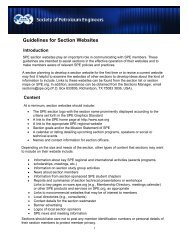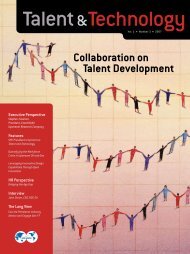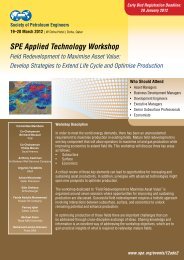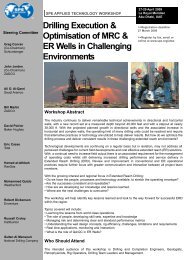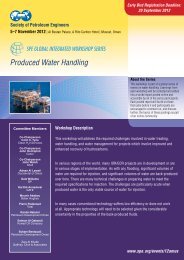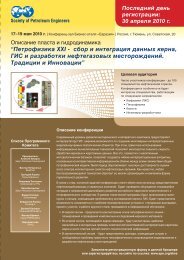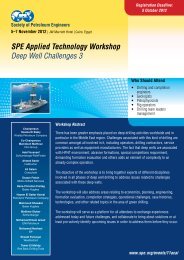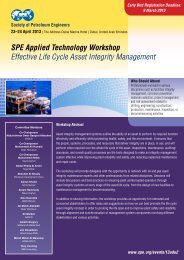The R&D Challenges to Secure Energy Supply for - Society of ...
The R&D Challenges to Secure Energy Supply for - Society of ...
The R&D Challenges to Secure Energy Supply for - Society of ...
Create successful ePaper yourself
Turn your PDF publications into a flip-book with our unique Google optimized e-Paper software.
2<br />
world’s oil reserves, and another 30%<br />
indirectly through partnerships with<br />
national oil companies (NOCs), according<br />
<strong>to</strong> ConocoPhillips Chairman,<br />
President and CEO Jim Mulva. 6<br />
So while NOCs will continue <strong>to</strong><br />
play a major role in conventional oil<br />
supply, increasingly limited quantities,<br />
and restricted access will require<br />
IOCs <strong>to</strong> increase their focus<br />
on the development <strong>of</strong> both frontier<br />
environments and challenging hydrocarbons,<br />
comprised primarily <strong>of</strong><br />
heavy oil, shale oil, tight gas, coalbed<br />
methane (CBM) and tarsands. Additionally,<br />
gasification <strong>of</strong> coal and petroleum<br />
coke, gas-<strong>to</strong>-liquids (GTL) and<br />
the companion coal-<strong>to</strong>-liquids (CTL),<br />
and liquefied natural gas (LNG), will<br />
all play increasingly important roles in<br />
the coming years. 7<br />
<strong>The</strong> IEA also found that although<br />
global oil demand will continue <strong>to</strong> increase,<br />
and will remain the largest<br />
single fuel in the world energy use<br />
mix, its share will actually drop between<br />
2004 <strong>to</strong> 2030. 2 <strong>The</strong> gap will be<br />
made up with mainly natural gas and<br />
coal. Coal will experience the largest<br />
demand increase driven primarily by<br />
power generation, with China and India<br />
accounting <strong>for</strong> almost four-fifths <strong>of</strong><br />
the incremental increase.<br />
However, increasing fossil fuel<br />
prices, particularly gas, enable renewable<br />
energy sources <strong>to</strong> compete more<br />
economically in the electric power<br />
sec<strong>to</strong>r. Renewables also will have the<br />
potential <strong>to</strong> modify the fuel supply mix<br />
by creating new feeds<strong>to</strong>cks while providing<br />
environmental benefits. More<br />
than twice as much private equity<br />
investments were directed <strong>to</strong>ward renewable<br />
and clean energy technology<br />
in 2006 compared <strong>to</strong> 2005, said<br />
Chevron Chairman and CEO David<br />
O’Reilly, adding that the commercialization<br />
<strong>of</strong> the new technologies cannot<br />
be far behind. 8<br />
Consequently, both energy<br />
supply diversification and technical<br />
innovation through global R&D<br />
investments and collaboration will<br />
be crucial in meeting world energy<br />
demand and ensuring global energy<br />
security <strong>for</strong> the next generation and<br />
beyond.<br />
Industry collaboration/<br />
globalization<br />
Global collaboration is key <strong>to</strong> ensuring<br />
continued R&D investment and<br />
technology transfer. DeepStar, a joint<br />
industry technology development<br />
organization, focuses on developing<br />
the technology <strong>to</strong> meet its members’<br />
deepwater business needs <strong>to</strong><br />
increase production and reserves. 9 A<br />
collaboration among opera<strong>to</strong>rs, suppliers,<br />
regula<strong>to</strong>rs and academic and<br />
research institutes, DeepStar has a<br />
proven success record in accomplishing<br />
its vision <strong>to</strong> provide a <strong>for</strong>um<br />
<strong>to</strong> execute deepwater technology development<br />
projects worldwide and <strong>to</strong><br />
leverage the financial and technical<br />
resources <strong>of</strong> the global deepwater industry.<br />
0<br />
<strong>The</strong> American and European<br />
Drilling Engineering Associations<br />
(DEA and DEA-Europe) both provide<br />
an effective vehicle <strong>for</strong> industry collaboration<br />
<strong>to</strong> improve access <strong>to</strong> drilling<br />
technology and in<strong>for</strong>mation on a<br />
worldwide basis. Opera<strong>to</strong>rs’ technology<br />
needs and gaps are identified<br />
and prioritized, which are then communicated<br />
<strong>to</strong> suppliers, who propose<br />
innovative solutions at workshops and<br />
other venues.<br />
Another example <strong>of</strong> industry collaboration<br />
<strong>to</strong>ok place in late 2006 in<br />
Canada, where R&D got a boost with<br />
the signing <strong>of</strong> a Memorandum <strong>of</strong> Understanding<br />
between the Petroleum<br />
Technology Alliance Canada (PTAC)<br />
and industry partners, including most<br />
<strong>of</strong> Canada’s opera<strong>to</strong>rs, namely the<br />
Canadian Association <strong>of</strong> Petroleum<br />
Producers and the Small Explorers<br />
and Producers Association <strong>of</strong> Canada.<br />
2 Started in 996, PTAC has facilitated<br />
industry collaboration, helping<br />
more than 200 R&D projects get <strong>of</strong>f<br />
the ground.<br />
Also facilitating technology transfer<br />
and application are pr<strong>of</strong>essional<br />
societies like the <strong>Society</strong> <strong>of</strong> Petroleum<br />
Engineers (SPE) and the American<br />
Association <strong>of</strong> Petroleum Geologists<br />
(AAPG). For example, specific SPE ef<strong>for</strong>ts<br />
supporting industry R&D include<br />
creating the R&D Providers Direc<strong>to</strong>ry<br />
now accessible on www.SPE.org and<br />
organizing the first R&D Conference<br />
<strong>The</strong> R&D <strong>Challenges</strong> <strong>to</strong> <strong>Secure</strong> <strong>Energy</strong> <strong>Supply</strong> <strong>for</strong> the Third Trillion and Beyond<br />
held in San An<strong>to</strong>nio, Texas, last April<br />
2007. Also, one <strong>of</strong> the roles <strong>of</strong> SPE’s<br />
R&D Committee is <strong>to</strong> promote interaction<br />
among universities, governments<br />
and industries. In another example,<br />
AAPG supports R&D through its Committee<br />
on Research, whose mission<br />
includes research idea interchange<br />
and in<strong>for</strong>mation distribution through<br />
conferences and symposia. 3<br />
University collaboration/<br />
globalization<br />
On the one hand, collaboration is<br />
more essential than ever between<br />
industry and academia. One <strong>of</strong> the<br />
main ways it can be promoted is by<br />
having broader industry participation<br />
in university research programs. On<br />
the other hand, universities must focus<br />
on research that is relevant and<br />
attractive <strong>to</strong> companies that support<br />
it, while still preserving the freedom <strong>of</strong><br />
academic pursuit. Collaboration also<br />
is crucial within academia, which can<br />
be facilitated via networks, <strong>for</strong>ums<br />
and non-conventional exchanges<br />
among universities and their departments.<br />
However, government regulations<br />
regarding intellectual property<br />
can provide obstacles even <strong>for</strong> interuniversity<br />
collaboration.<br />
As far as globalization is concerned,<br />
universities now have a global<br />
presence more than ever be<strong>for</strong>e.<br />
A prime example is Education City, a<br />
2,400 acre multi-university campus located<br />
in Qatar’s capital <strong>of</strong> Doha, which<br />
houses several universities <strong>of</strong>fering<br />
programs available at their respective<br />
main campuses. <strong>The</strong> Qatar Foundation<br />
has facilitated the presence <strong>of</strong><br />
Texas A&M University and Carnegie-<br />
Mellon University on its campus, with<br />
the <strong>for</strong>mer <strong>of</strong>fering BS and MS degrees<br />
in engineering, including petroleum<br />
engineering, with a student body<br />
<strong>of</strong> 200 this year. 4 <strong>The</strong> latter <strong>of</strong>fers BS<br />
degrees in business and computer<br />
science. 5 In both cases, the degrees<br />
have the standing <strong>of</strong> degrees from the<br />
host campuses.<br />
Education <strong>of</strong> pr<strong>of</strong>essionals, public<br />
<strong>The</strong> oil and gas industry is facing a<br />
shortage <strong>of</strong> technical pr<strong>of</strong>essionals in<br />
the US and Western Europe, where






